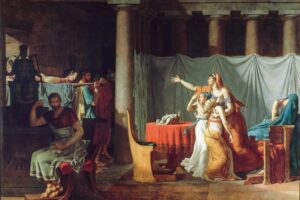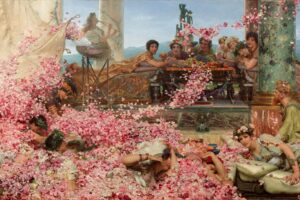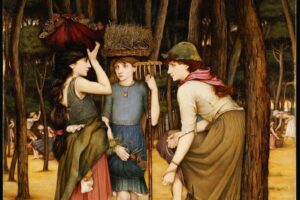Jacques-Louis David, 1784
A Forgotten Hero at the Gates of Power
Once celebrated across the empire, Belisarius—the brilliant general of the Byzantine army—now sits in rags beside a columned building, half-shadowed by its grandeur. He does not beg for himself alone. In his arms, wrapped in his worn cloak, is a child—young, wide-eyed, and innocent.
This is not a scene of glory. It is a moment of quiet dignity and undeserved suffering. Jacques-Louis David painted this in 1784, not simply to depict a historical figure, but to raise a question still relevant today: How do we treat those who once gave us everything?
The Legend Behind the Painting
Belisarius was one of the greatest generals of the 6th century, known for his loyalty and courage under Emperor Justinian. He defended the empire and restored lost lands, yet legend says he was later accused of betrayal, blinded, stripped of honor, and left to beg.
Historians debate the accuracy of this tale, but David embraced it as a powerful story of injustice. He painted Belisarius not with bitterness, but with profound grace and human truth.
A Scene of Quiet Drama
The painting captures a poignant moment: a woman, cloaked in soft folds of ivory and gold, kneels to place coins in the helmet of the now-blind Belisarius. Her gesture is gentle, almost reverent. Behind her, a soldier—perhaps one who once served under Belisarius—halts in shock as recognition strikes.
But the heart of the painting lies in the seated figure himself. Belisarius, old and blind, holds a young child—possibly his son, or a symbolic orphan. The child clutches him in trust, and together they form a powerful image: one hand begging, the other protecting. Even in ruin, Belisarius shields the next generation.
A Warning in Paint and Stone
David was not just painting the past—he was speaking to his own time. France in the 1780s was a society on the brink of revolution. He saw how easily those in power could cast aside their faithful servants. By choosing this subject, David asked his viewers to reflect on honor, gratitude, and the responsibilities of a just society.
The architecture around them—Roman columns, sculpted reliefs—evokes both greatness and decay. This contrast makes the story more powerful. The empire may still stand, but its moral vision is crumbling.
Why This Painting Still Speaks
Belisarius Begging for Alms reminds us that strength is not always seen in armor. Sometimes, it is found in humility, in the act of holding a child close while asking for help. The painting teaches compassion, remembrance, and the quiet heroism of those who endure.
It speaks to every age and every heart—those who’ve been forgotten, those who’ve given much, and those who still carry dignity even when the world turns away.
About Artist

Jacques-Louis David (1748–1825) was a French painter who became the leading figure of Neoclassicism, a movement that rejected the frivolity of the Rococo and sought to revive the moral and aesthetic values of ancient Greece and Rome. His art was not just beautiful; it was a powerful tool for political and social change. David’s work defined a new style that was severe, intellectual, and deeply political, making him a central figure in the French Revolution and later, the court of Napoleon Bonaparte.
Artistic Style and Legacy
David’s style is characterized by a dramatic shift from the soft, sensual curves of Rococo to the sharp lines and moral clarity of Neoclassicism. His paintings are known for:
- Classical Themes and Heroes: He drew heavily from ancient history and mythology to tell stories of virtue, civic duty, and self-sacrifice.
- Sharp, Defined Lines: He rejected the loose brushwork of the Rococo in favor of crisp, sculptural forms that give his figures a sense of heroic grandeur.
- Moral and Political Messages: His art often served as propaganda, urging viewers to embrace patriotism and civic virtue.
- Controlled Lighting: He used strong, raking light to emphasize form and clarity, avoiding the dramatic tenebrism of the Baroque.
Artwork Profile
Here paintings represent the full range of his career, from his early Neoclassical masterpieces to his later works for Napoleon.
- Belisarius Begging for Alms (1781): An early Neoclassical work that depicts the Roman general Belisarius, unjustly fallen into disgrace, begging for money. It’s a clear moral statement about the cruelty of the state.
- The Lictors Bring to Brutus the Bodies of His Sons (1789): A powerful and stark depiction of a Roman leader who chose civic duty over personal love. This painting, with its clear composition and somber tone, was seen as a call for revolutionary sacrifice.
- The Farewell of Telemachus and Eucharis (1782): A more sentimental and intimate work from his early career, it depicts a scene from a classical novel, showing his softer side before his full turn to political subjects.
- The Death of Socrates (1787): One of his most famous masterpieces. It portrays the Greek philosopher Socrates as a moral hero calmly facing death. The painting’s noble composition and stoic emotion made it an icon of Enlightenment ideals.
- The Anger of Achilles (1819): This late painting, from his exile in Brussels, shows David returning to classical subjects with a more refined and emotionally charged style.
- Oath of the Horatii (1784): Arguably his most famous work and a manifesto of Neoclassicism. It depicts three Roman brothers swearing an oath to their father, prioritizing duty to Rome over family. Its stark, geometric composition and powerful moral theme made it an instant sensation.
- Napoleon Crossing the Alps (1801): A famous equestrian portrait of Napoleon as a heroic figure. The painting is a work of political propaganda, portraying Napoleon as a dynamic and determined leader.
- The Emperor Napoleon in His Study at the Tuileries (1812): A more intimate portrait of Napoleon, but one that still emphasizes his power and intellectual prowess. It shows the emperor standing in his study late at night, a subtle nod to his tireless work ethic.



